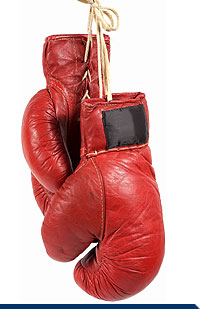 |
Choosing Your Right
Boxing Glove Size and Handwraps
When picking out a pair
of boxing gloves, choosing one that best fits
your hand is not exactly the right criteria
you should follow. Try putting on handwraps
underneath the gloves. 120" handwraps
are right for small hands. For medium to large
hands, you will want 170" or longer.
Why bother with handwraps?
When boxing, you will need to support your
wrist and thum to protect your bones and tendons
from injury. It is important that you always
wrap your hands before working out or boxing.
|
|
|
BOXING FOR
BETTER HEALTH: Do
you want the strength of undefeated boxer
Laila Ali or the body of heavyweight champion
Lennox Lewis? [ More
]
A KNOCKOUT WORKOUT:
Here's how you can do
it at home. [ More
] |
 |
|
Boxing Tips
A knockout workout: boxing offers
a unique, all-body cardio and strength-training
workout. Here's how you can do it at home
Personal Trainer - Men's Fitness, August, 2002
by Roy M. Wallack
Thunk! Thunk! Thunk! Left jab. Overhand Rattling
left hook. "Take that, you big, ugly, no-talent,
go-cry-home-to-Mama ... bag!"
Whether it's dressed up as box-aerobics, cardiobox,
slug-mania or one of a dozen other names, the sport
of boxing has become a heavyweight in the fitness
world. You can now find boxing classes, or some
offshoot, in 21 percent of all U.S. health clubs,
according to the American Council on Exercise. And
that figure is rising.
To discover what all the fuss is about, I went mano-a-mano
with 100-bags for one week and learned what so many
others before me have already discovered: Boxing
delivers a peerless total-body workout--which you
don't need to attend a class to get.
BRINGING IT ALL BACK HOME
Boxing alone? At home? It's not as silly as it seems.
No sparring partner is needed, and the equipment
requirements are elementary: a bag, gloves, jump
rope, timer and music. And you'll get a workout
that doesn't miss a spot: a 1,000-calorie-an-hour
cardio bomb on par with running, and a superb all-body
tuner that builds shoulders and forearms and works
legs, hips, abs, upper back, triceps, biceps and
lats. (Want to blast your delts? Try holding 14-ounce
gloves at chin level for two rounds.)
Moreover, a boxing-based workout offers you an opportunity
to develop real-life skills during a cardio session,
to learn the sweet science that many men think they
should know, something that buoys their sense of
their own manhood.
For others (okay, for me), it's a chance to unleash
their inner Ali, to trash-talk the hapless heavy
bag with jabs like "You dumb gorilla!"
or the Sonny Liston-inspired "I'll beat you
so bad, you'll need a shoehorn to put your hat on!"
In fact, as home workouts go, I'd say that boxing
might just be The Greatest.
THE RULE OF THREE
First, find an instructor with genuine boxing experience
and take a couple of days to learn the basics--jab,
straight right, hook, footwork, etc.--either through
private lessons or a small class (as low as $15
a session). Barring that, see the "Technique"
sidebar (page 108) for a quick primer on boxing
basics; sooner or later, though, you'll want to
invest in a lesson to see how you're progressing
and to stay motivated.
Next, clear a space in your apartment, basement
or garage (under a strong rafter) for a heavy bag
and other gear itemized in the "Equipment"
sidebar (below). And be sure to follow a good boxing-workout
regimen, such as the one outlined here (opposite
page).
I took my lessons from former professional welterweight
fighter Steve Petramale, owner of Shadow Boxing,
a hard-core Hollywood boxing studio with its own
roped ring. Petramale is a purist who cringes at
the term box-aerobics; he teaches "boxing class."
And he does everything by the book--the way pro
boxers do.
Petramale stresses the importance of the number
three. Three-minute rounds on the heavy bag, to
simulate a boxing match. Three rounds of hitting
the bag, which, Petramale says, is "as much
punishment as you can take without compromising
form." Plus, everything you do, from shadowboxing
to jumping rope, from sit-ups to stretching, do
for three minutes.
For the last 30 seconds of each three-minute period,
you'll want to increase your intensity, just as
fighters do in the last rounds of a close fight.
(This focus on time requires a timer--anything from
a $5 egg timer to a $150 programmable alarm bell
featuring a 30-second warning buzzer, adjustable
rest periods and multicolored flashing lights.)
In between each three-minute burst, there's one
minute of rest. Real rest. "You don't see a
boxer jogging in place during rounds, do you?"
says Petramale, not waiting for an answer. "He's
sitting in his corner, resting, getting a drink,
because he wants to be at his best when he goes
back out. And how can he do that when he's out of
breath?"
Granted, most people don't go to a cardiobox class
to rest; some instructors have their students sprint
and do push-ups during breaks from flailing at the
bag. And I do mean flailing; the emphasis appears
to be on speed--in other words, quantity, not quality.
It's a grueling cardio workout, but it may as well
be Spinning. Remember: The objective here is to
get a workout and hone your newfound boxing skills.
If you must jog as you rest, take it easy.
The workout schedule (page 111) sticks to the "three
minutes on, one off' rule, and gives you a choice
of a short (31-minute) or long (48-minute) version.
All ab work or push-ups are done after a round of
boxing; done earlier, they'll tighten muscles and
compromise form, says Petramale. If you're superfit
and desire a longer workout, just add more jump-roping
at the start and more push-ups at the end.
One more thing: Don't worry if you initially float
like driftwood and sting like a gnat. According
to Petramale, if you take a lesson and follow up
two or three times, the butterfly and the bee will
emerge within two weeks.
BASIC TECHNIQUE
To maximize your time on the bag, learn the fundamentals.
1 CLASSIC BOXING STANCE
Stand almost sideways to your imaginary foe (or
bag), feet more than shoulder-width apart. If you're
right-handed, put your left foot forward and right
foot back If you're left-handed, reverse your positioning.
Line up your front foot, hip and shoulders, with
your weight equally distributed on the balls of
each foot and your knees slightly flexed. You should
feel balanced and able to move easily, as if dancing:
2 HAND/ARM POSITION
Keep your hands up in front of your mouth and chin,
with the lead hand about six to eight inches ahead
of the rear. Tucking the elbows in protects your
ribs and recruits your hips into your punches for
more power. The rear elbow should rest near your
ribs. How will you know you're doing it right? When
you can, use your lead-hand knuckles as a "sight."
3 THE PUNCHES
Properly thrown punches snap straight out from the
chin, then retract straight back. This provides
maximum power and minimizes the time your fist leaves
your chin unguarded.
If you're throwing quality punches, the bag should
not sway wildly when hit. "If you snap the
punch," says Petramale, "you fee[ a solid
thud and see the bag shudder."
3a Jab: Fire your fist out on a straight line like
a bullet, twisting your thumb inward at full extension.
Don't shift your body balance forward or move either
foot forward; doing so restricts power.
3b Rear straight/ cross: Starting with your rear
fist almost touching your chin, and your elbow tucked
into your ribs, explode your arm straight out. Trying
to keep your back leg straight, pivot on the ball
of your foot and rotate your hip as far forward
as possible. The punch will be longer, stronger,
faster.
3c Lead hook: Your fist starts in the same place
as with a normal jab. But instead of keeping your
elbow angled down, pivot it outward so your forearm
is parallel to the ground. Then snap your hip so
that your upper body twists and your punch slams
sideways into an imaginary cheekbone.
SHADOWBOXING
Don't dismiss this old-school training method. If
your technique is off when you perform in front
of a mirror--where you can watch yourself--it won't
be correct when you're on the heavy bag or in the
ring. "Shadowboxing is like watching a videotape
of yourself and self-correcting," says former
boxer Steve Petramale. "It's a great way to
study and improve your form."
In your boxer's stance, practice moving in all directions:
forward, back and side-to-side. Next, incorporate
some jabs with your steps, Throw your jab as you
step forward with your lead leg. Shadowbox in slow
motion to isolate troublesome combinations.
HOME-BOXING EQUIPMENT
For a good home-boxing workout, you need the right
stuff. Try our recommendations:
1. Everlast 14-ounce leather training gloves with
Velcro wrist closure ($50)
2. TKO wrist wraps ($6)
3. Egg timer ($10)
4. Leather jump rope ($12)
5. Century Wave Master 100-pound heavy bag ($100)
THE SCHEDULE
SHORT PROGRAM--ACTIVITY & DURATION
* Jump rope, 3 minutes
* Rest/jog in place, 1 minute
* Jumping jacks/squats/stretch, 3 minutes: 20 seconds
each, then rotate (See below for stretching exercises.)
* Rest/jog in place, 1 minute
* Shadow boxing, 3 minutes (See sidebar, opposite
page.) Alternate 90 seconds each:
1) Be your own trainer. Watch yourself in the mirror
to correct stance, hand position, punching mechanics,
footwork.
2) Stick and move around an imaginary opponent.
Don't punch hard; you can't knock out the air.
* Rest/jog in place, 1 minute
* Boxing: Round 1--heavy bag, 3 minutes
One minute: Work on individual jab, hook and uppercut.
Next two minutes: Throw combinations.
Every 30 seconds: Throw flurry of punches for five
seconds. (It's difficult if done right.)
* Rest/jog in place, 1 minute
* Boxing: Round 2--heavy bag, 3 minutes Pick up
the pace. All combinations: double jab; triple jab;
1-2 (left, right); 1-2-3 (left-right, left hook
to chin).
* Rest/jog in place, 1 minute
* Boxing: Round 3--heavy bag, 3 minutes All combinations;
vary placement. Example: jab to chin, right to body;
jab to body, right to chin; right to body; jab to
chin, hook to chin; 1-2-3 jab to chin, right to
body, hook to chin.
* Rest/jog in place, 1 minute
* Jump rope, 3 minutes
* Rest/jog in place, 1 minute
* Shadowboxing, 3 minutes. Cool down. Work the jab.
* Rest/jog in place, 1 minute
* Short program end: stretching, 3 minutes
Shoulder/lat stretch: Put arm across chest, then
push it toward the center with opposite hand on
elbow.
Triceps stretch: Put hand over shoulder and push
elbow down with opposite hand.
Hamstring stretch: Bend at waist; touch floor with
palms.
LONG PROGRAM
(add these additional minutes to lengthen the program)
* Abs/push-ups, 3 minutes Alternate the two. Use
the following three abdominal exercises.
1. Crunch: With knees bent 90 degrees and feet flat,
curl your sternum toward your pelvis..
2. Bicycle: Bring opposite elbow to knee. (Petramale:
"If you do 50, you're a bad dude.")
3. Jackknife: Raise hands from chest to straight-legged,
airborne feet.
Push-ups: Alternate hand width each set. Do each
set to failure.
* Rest/jog in place, 1 minute
* Jump rope, 3 minutes
* Rest/jog in place, 1 minute
* Run in place fast, 3 minutes (Lift knees up high.
Run hard.)
* Rest/jog in place, 1 minute
* Stretch, 3 minutes (See above.)
* End: Go home! Oh, yeah. You are home.
[ILLUSTRATION OMITTED]
COPYRIGHT 2002 Weider Publications
COPYRIGHT 2002 Gale Group |
|